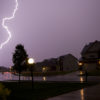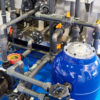Although you may have a pool filter as part of your backyard pool equipment, you may not know how it works to keep your pool clear and clean. Pool Troopers would like to help explain the workings of this important piece of equipment.
Water Circulation Pump
An electric motor spins an impeller inside the pump and that is what pulls the water through the return plumbing (suction side) and pushes the water to the Filter (pressure side). Debris that is small enough to bypass the skimmer basket or that travels through the main drain accumulates in the strainer basket that is located in front of the pump. The water is then pushed to the filter to be cleaned further.
Filtration
The water, free of leaf debris, is then pumped into the filtration system. Water might then pass through the filters media which can be fabric, sand, diatomaceous earth, or other media. These media are contained in side the filter housing which is usually a fiberglass, metal, or plastic tank.
Water that is dirty comes through the inlet pipe of the filter and distributed within the tank. Pressure or Gravity is at work as the dirty water moves through the media filtering out any dirt, debris, algae, and bacteria as well as some larger microorganisms. Metals and minerals may also be removed by filtration.
Filtered water then flows to the outlet pipe and is returned into the pool through the return plumbing.
The flow is slowed as the filter media collects dirt and debris over time. Pressure Gauges alert you to the amount of collected dirt, as the pressure increases on the gauge. If there is 10 pounds more pressure on the dirty filter compared to the clean filter pressure (Starting Pressure), it is time to clean or backwash the filter.
Backwashing involves redirecting the flow of water by adjusting the valves. First turn the system off! Never adjust valves while the filtration system is operating. The return pipe is closed, and the drainage pipe is opened. A multiport valve does this for you by simply turning it to the backwash position. The drainage pipe is the one that leads to a waste line. Turn the system back on and water that is dirty flows to the waste line.
If you have a multiport valve, turn the system off again and move the valve to “rinse” position and run the system of 5-10 seconds. Turn the system off and repeat the backwash rinse cycle until the waste water looks clear. Usually 3 times. DE and Sand filters usually have multiport valves that allow for backwashing.
Cartridge filters need to be manually cleaned. Please see our videoon proper manual cleaning of a cartridge filter.
Types of Pool Filters
You have several choices when it comes to a pool filter. You might be asking which is the best type for your in-ground pool? This will depend on your needs, budget and time. The three types of filters are:
- Sand filter
- Cartridge filter
- DE filter
Cartridge filters engage the water to flow through corrugated paper or polyester cloth. There is no ability to backwash; the filter is manually cleaned and in normal sized filters the element needs to be replaced every 12-18 months. Oversized cartridge filters can last several years. The filters typically filter down to 10 microns (good) and are mid to high priced. They do require more work to clean but if you have a service they are a good option.
The DE filter, diatomaceous earth filter, filters the water as it flows through grids that are coated with the fine powder of fossils. This fossilized powder is made of diatoms, the remains of sea organisms. The filter is cleaned periodically by backwashing and annually or semiannually it needs to be taken apart and cleaned to remove any De that backwashing doesn’t get out. It filters to 3-5 microns (best) and is easy to maintain though it should be professionally cleaned and reassembled. They tend to be the most expensive filters.
Sand filters typically use sand media to filter the water though there are encouraging alternative media being used in the filters today. They can be cleaned with a multiport and are the easiest filters to use. They filter down to 20 microns (least, though alternative media does better per claims-we are testing). They tend to be mid-priced.
You can choose the system that works best for you.
Filtering time
Most regions dictate that the water in a public pool must pass through the filter multiple times per day. This is called “turnover rate”.
Residential pools have no such rules but it is suggested that residential pools “turn over” at least two times per day in the swim season and at least once every 24 hours in the off season. Your pool should have been designed with the ability to turn over multiple times per day. Normal run times are 8-10 hours of filtration a day though if you utilize a variable speed motor your run times will greatly increase as your motor speed reduces.
Preventive maintenance also helps save on costs of running your filter system. Understanding how your filtration system works is important. Skimmers should be checked regularly, and leaves and debris should be removed to make the system run more efficiently. A filter is only one part of four of a properly maintained pool- Circulation, Filtration, Chemicals and Cleaning.
Pool Troopers can help you with pool cleaning whether it is do-it-yourself or part of our maintenance service. With a variety of services available, your pool filter can be cleaned and monitored as well as water tested. Give Pool Troopers a call to learn more about how we can help you make sure that your filtration system is working efficiently. Then relax and enjoy your pool while we do the work.



